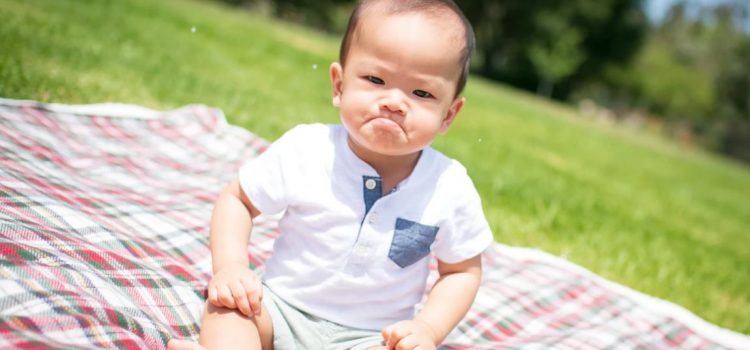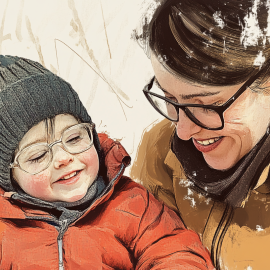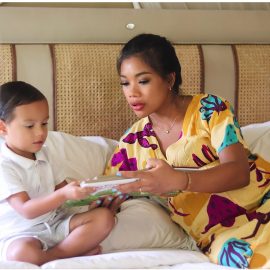

This article is an excerpt from the Shortform book guide to "Oh Crap! Potty Training" by Jamie Glowacki. Shortform has the world's best summaries and analyses of books you should be reading.
Like this article? Sign up for a free trial here .
What are the most common potty training problems? How can you help your child overcome resistance to potty training?
In her book Oh Crap! Potty Training, parenting coach and social worker Jamie Glowacki goes over the four most common potty training problems. Those problems include poop difficulties, night training, resistance, and restarting.
Below, we’ll go over the four potty training problems and how to overcome them, according to Glowacki.
Common Potty Training Challenges
In her book Oh Crap! Potty Training, Glowacki emphasizes that every child is different and will probably encounter problems when potty trained. She mentions four common potty training problems your child might encounter and suggests how to approach each of them.
Problem #1: Poop Difficulties
Your child might have an easier time peeing in a toilet than they do pooping, which Glowacki says is perfectly normal. She offers three reasons a child might have trouble pooping in a toilet and advises how you can deal with each.
Anxiety
Just like adults, children have a hard time pooping while anxious. Glowacki explains this is a physical response—the sphincter muscles close up the anus in response to anxiety. To reduce anxiety, make pooping a normal and calm event. Talk openly with your child about poop, and offer them privacy while pooping since a parent hovering or watching often adds pressure. (Shortform note: While anxiety alone can prevent pooping, research shows anxiety around pooping can also cause constipation (another common cause of poop difficulty, as we’ll explore in a moment). This suggests that mental and physical blocks to pooping can be linked and that addressing one can help address the other.)
Poop Rhythms
Glowacki suggests that once your child is out of diapers, they’ll likely poop less often than usual and might not poop at all the first day or two—this is perfectly normal. Pooping outside of a diaper is a new and strange feeling for your child. Help them get used to pooping by validating their feelings. This can mean talking openly about poop and how strange it feels or it could just mean giving them plenty of time to poop.
(Shortform note: While Glowacki discusses how pooping can be an odd and difficult experience for your child, they might also find it an emotionally satisfying one—this feeling is what gastroenterologist Dr. Anish Sheth (What’s Your Poo Telling You?) calls “poo-phoria.” This is because pooping directly stimulates the vagus nerve in your brain, which controls both mood and basic functions like the digestive system. Stimulation of the vagus nerve has been shown to help treat depression, anxiety, and post-traumatic stress disorder.)
Physical Difficulty
Difficulty pooping can also have physical causes like constipation. Glowacki recommends multiple methods for easing these difficulties: Try positioning your child in a squatting position on or over the potty—this stance helps poop come out. Also, make sure your child stays hydrated and eats enough healthy fats and fiber. If nothing else works, you can also ask your pediatrician about child-friendly stool softeners or a further examination. (Shortform note: You might be wondering when to contact a pediatrician about constipation in your child. Pediatricians recommend doing so if the constipation has lasted longer than two weeks, prevents normal activities, or causes your child consistent pain and irritation.)
Problem #2: Night Training
Glowacki claims that your child might automatically wake up to use the potty at night, but if this doesn’t happen by the time your child is three to three and a half then you’ll need to take concrete nighttime potty training steps. She offers two main steps for nighttime training:
1) Make sure your child doesn’t drink too much before bed. This way, they’ll pee less frequently at night and have fewer accidents. (Shortform note: Experts recommend avoiding sugary drinks in particular, as they act as diuretics, drawing more water into the bladder.)
2) Set two alarms at different points of the night (experiment to find the best times for preventing accidents), wake up your child, and have them pee in the potty. This consistent approach helps your child practice nighttime potty use. (Shortform note: Contrasting with Glowacki’s suggestion that waking your child is a necessary step for night training, some experts argue that while waking your child to pee will reduce accidents, it’s not crucial for night training.)
Problem #3: Resistance
While potty training, your child might resist the process. Glowacki separates reasons for resistance into two categories and offers suggestions for dealing with each.
Uncertainty
Your child may resist potty training because they feel uncertain about changing their routine or learning a new skill. Address uncertainty resistance by staying confident and making it clear that your child has to learn to use the potty. Also, don’t over prompt or hover over them while they use the potty—this only adds pressure on your child, which increases their uncertainty. Instead, prompt your child to use the toilet and then let them do it on their own.
(Shortform note: While Glowacki argues you should stay firm and confident in the face of uncertainty, Daniel J. Siegel and Tina Payne Bryson offer a contrasting suggestion in No-Drama Discipline: Have a dialogue with your child. By asking your child how they feel and expressing empathy, they’ll feel understood and will calm down. This helps them explain their behavior to you, and gives you space to explain your expectations to them. Simply remaining firm, like Glowacki suggests, doesn’t allow for a productive dialogue—you’re only expressing your needs and not hearing the needs or feelings of your child.)
Defiance
The other form of resistance Glowacki identifies is defiance: when your child knows how to use the toilet but chooses not to. This happens because your child is testing their limits (a normal developmental activity), or because they just don’t want to get up from an activity. In these situations, Glowacki recommends using small consequences: Have your child help you clean up the accidents, or take away a toy until they use the potty. This way, your child will recognize that their on-purpose accidents have consequences, discouraging that behavior.
| Planning Consequences When you need to decide on a consequence for your child, Daniel J. Siegel and Tina Payne Bryson (No-Drama Discipline) recommend you take a moment to think—instead of emotionally responding in the moment—by asking yourself three questions: Why did my child behave this way? What lesson do I want them to learn from my discipline? How do I deliver that lesson? By reflecting on these three questions, you can make sure your discipline communicates the behavior you expect from your child in a clear and consistent way. |
Problem #4: Restarting
Glowacki acknowledges that there might be a moment when it’s necessary to return to diapers for a time and then start potty training over later on. She calls this process “restarting” your training, and notes two main circumstances where a restart might be necessary:
1) Exhaustion: You and your child have hit your physical and emotional limits, and continuing to train won’t be productive—this is likely due to excessive resistance and power struggles. (Shortform note: While Glowacki recommends resetting if you experience intense emotional exhaustion, experts note that there are steps you can take to help prevent intense emotional exhaustion. They recommend three main methods of self-care to prevent emotional exhaustion: setting up a network of supportive people you can talk to, avoiding self-judgments or too-high expectations, and regularly reminding yourself of the positive aspects of parenting.)
2) Lack of understanding: Your child either never tried to understand training, or started to understand and then suddenly and unexpectedly stopped or regressed in their understanding. (Shortform note: Glowacki mentions that difficult emotional situations like moving or a new sibling can cause potty training to regress, or make your child unwilling to learn toilet use. Experts explain why this happens: During a big emotional shift or major life event, toddlers need to feel in control over their lives. Bodily functions are one of the few things they can control, and so toddlers try to maintain that control by resisting or ignoring their parent’s instructions.)
How to Effectively Restart
To restart your child’s potty training, put them back into diapers but explain to them that you’re only doing so because they can’t use the potty properly and you need everyone to calm down before trying again. Put away the potty chair, and pick a day for restarting potty training two to four weeks later. These steps will allow everyone to calm down before trying again and will frame the restart as a break rather than as inconsistency in your approach.
However, there are also limits to the restart. Glowacki emphasizes that the reset can only be done once—resetting more than once teaches your child that throwing a big fit gets them what they want. She also insists that you should not reset the training of a child older than three, because a failure to potty train at that age is most likely due to behavior rather than an inability to learn.
(Shortform note: You might be wondering what to do when your child is older than three years but still resists potty training. At this stage, some experts suggest you make it clear to your child that you expect them to use the toilet, stop prompting them entirely, and praise them if they do use the toilet. Experts argue that when you do this, your child will realize they no longer get attention for not using the toilet. From there, they will realize that they can get attention (praise) by using it the way you expect them to, encouraging toilet use.)
| Plan Before Restarting Before restarting potty training, experts recommend identifying what prevented your first attempt from succeeding and planning how you’ll deal with that obstacle the second time around. These obstacles can generally be placed into four categories: developmental, emotional, physical, or behavioral. – Developmental obstacles can usually be solved by just waiting for a longer period so your child can grow and develop. – Emotional challenges, like fear of the potty or lack of interest, can often be addressed with potty training songs, books, or dolls. – Physical challenges are usually connected to constipation and can often be addressed by a diet adjustment or a pediatrician. – Behavioral obstacles can often be solved by finding ways to calm your own anxiety (which, as we discussed, your child may be picking up on), or easing up on prompting and hovering over your child’s bathroom use. |

———End of Preview———
Like what you just read? Read the rest of the world's best book summary and analysis of Jamie Glowacki's "Oh Crap! Potty Training" at Shortform .
Here's what you'll find in our full Oh Crap! Potty Training summary :
- How to practice the Oh Crap! Potty Training method
- How to overcome a number of potty training challenges
- What to do if you need to restart the potty training process






